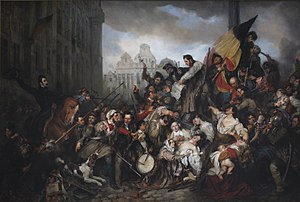| Part of the revolutions of 1830 | |
 Episode of the Belgian Revolution (1834) by Gustaf Wappers, a giant painting depicting a romantic ideal of the Belgian Revolution (Royal Museums of Fine Arts) | |
| Date | 25 August 1830 – 17 November 1830 (84 days), but Belgian independence not fully consolidated until 1839 |
|---|---|
| Location | Southern provinces of the United Netherlands (modern-day Belgium, Luxembourg, and Dutch Limburg) |
| Cause | Widespread dissatisfaction with political and economic conditions in the United Netherlands |
| Outcome | Belgian independence
|
The Belgian Revolution (Dutch: Belgische Revolutie, French: Révolution belge) was a national uprising which led to the independence of Belgium from the Dutch-dominated United Netherlands in 1830. It was part of a wave of revolutions across Europe in the same year.
The Low Countries, which had been divided since the 16th century, were formed into a single polity in 1815 as part of the political re-organisation of Europe after the Napoleonic Wars. The new state, known as the United Netherlands, was a constitutional monarchy under King William I but struggled to reconcile the economic, political and cultural differences between its northern and southern provinces. Resentment against the United Netherlands grew in the south among liberals and Catholics who believed that the government favoured northern interests and sought additional political representation. The two factions came together in 1828 to form a "Union of Oppositions" to demand reform.
On 25 August 1830, a political demonstration broke out in Brussels after a showing of the nationalistic opera La Muette de Portici. It soon escalated into rioting, leading the middle class to form militias to protect their property.
- Diplomatic efforts with the Dutch
William I despatched a large military force to Brussels to re-establish order. It entered the city on 23 September, encountering a smaller but radicalised Belgian rebel force. After three days of fighting—known as the “September Days”—they were forced to withdraw from the city. The revolutionary’s victory led to mass defections from the Dutch army and small uprisings in provincial centres across Belgium.
- Dutch forced out of Belgium by 21 October, except at Antwerp…
After the September Days, leading revolutionaries in Brussels had formed a revolutionary Provisional Government. On 4 October, it declared Belgium an independent state and began making arrangements to create a political system for the new state. An elected National Congress was created to draft a constitution and sat for the first time on 10 November. It ultimately settled on a liberal-inspired constitutional monarchy, choosing Leopold I as the first king.
- Actual "revolutionary phase" of events spanned from 25 August to 17 November 1830. However, the new Belgian state was not established until 21 July 1831 and remained insecure for several years. It was only in 1839 that it received Dutch recognition.
© MMXXIII Rich X Search. We shall prevail. All rights reserved. Rich X Search
